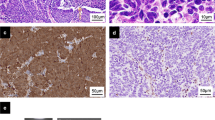Abstract
The aim of this study was to examine the role of p16 in the pathogenesis of squamous carcinoma of the gynecologic tract. Squamous carcinoma and carcinoma in situ from the female genital tract were examined for the expression of p16 by paraffin immunohistochemistry. About 74% (40/54) of cases showed p16 expression. By primary site, 77% (23/30) of cervical, 67% (6/9) of vaginal and 85% (11/13) of vulvar primaries expressed p16, but two endometrial primary squamous carcinomas were negative (0/2). In addition, p16 was not identified in non-dysplastic tissue and low grade dysplasia. In cases where there were matched vaginal or vulvar and cervical primaries in a given patient, there was concordant positive p16 expression. It is concluded that p16 is frequently expressed in squamous carcinoma of the cervix, vagina and vulva, but not seen in cases of benign and low grade lesions. It may be a marker of transformation from a low to a high grade lesion. More cases of endometrial primaries need to be studied to see if these evolve by a p16-independent pathway.
Similar content being viewed by others
References
Bibbo M, Klump WJ, DeCecco J, Kovatich AJ (2002) Procedure for immuno-cytochemical detection of p16 INK4A antigen in thin-layer liquid-based specimens. Acta Cytol 46: 25–29.
Chan MK,Cheung TH, Chung TK, Bao SY, Zhao CL, Nobori T, Wong YF (1998) Expression of p16 INK4 and retinoblastoma protein Rb in vulvar lesions of Chinese women. Gynecol Oncol 68: 156–161.
Giarre M, Caldeira S, Malanchi I, Ciccolini F, Leao MJ, Tommasino M (2001) Induction of pRb degradation by the human papillomavirus type 16 E7 protein is essential to efficiently overcome p16 INK4a-imposed G1 cell cycle arrest. J Virol 75: 4705–4712.
Hirama T, Miller CW, Wilczynski SP, Koeffler HP (1996) p16 (CDKN2/cyclin-dependent kinase-4 inhibitor/multiple tumor suppressor-1) gene is not altered in uterine cervical carcinoma cell lines. Mod Pathol 9: 26–31.
Keating JT, Cviko A, Riethdorf S, Riethdorf L, Quade BJ, Sun D, Duensing S, Sheets EE, Munger K, Crum CP (2001a) Ki-67, Cyclin E, and p16 INK4 are complementary surrogate biomarkers for human papilloma virus-related cervical neoplasia. Am J Surg Pathol 25: 884–891.
Keating JT, Ince T, Crum CP(2001b) Surrogate biomarkers of HPVinfec-tion in cervical neoplasia screening and diagnosis. Adv Anat Pathol 8: 82–92.
Kim JR, Kim SY, Kim MJ, Kim JH (1998a) Alterations of CDKN2(MTS1/p16 ink4A ) gene in paraffin-embedded tumor tissues of human stomach, lung, cervix and liver cancers. Exp Mol Med 30: 109–114.
Kim YT, Cho NH, Park SW, Kim JW (1998b) Underexpression of cyclin-dependent kinase (CDK) inhibitors in cervical carcinoma. Gynecol Oncol 71: 38–45.
Klaes R, Benner A, Friedrich T, Ridder R, Herrington S, Jenkins D, Kurman, RJ, Schmidt D, Stoler M, von Knebel Doeberitz MK (2002) p16INK4a immunohistochemistry improves interobserver agreement in the diagnosis of cervical intraepithelial neoplasia. Am J Surg Pathol 26: 1389–1399.
Klaes R, Friedrich T, Spitkovsky D, Ridder R, Rudy W, Petry U, Dallenbach-Hellweg G, Schmidt D, von Knebel Doeberitz M (2001) Overexpression of p16 INK4A as a specific marker for dysplastic and neoplastic epithelial cells of the cervix uteri. Int J Cancer 92: 276–284.
Liggett WH, Sidransky D (1998) Role of the p16 tumor suppressor gene in cancer. J Clin Oncol 16: 1197–1206.
Lin WM, Ashfaq R, Michalopulos EA, Maitra A, Gazdar AF, Muller CY (2000) Molecular Papanicolaou tests in the twenty-first century: Molecular analyses with fluid-based Papanicolaou technology. Am J Obstet Gynecol 183: 39–45.
Lorincz AT (1996) Hybrid capture method for detection of human papillomavirus DNA in clinical specimens. J Obstet Gynaecol Res 22: 629–636.
Nakao Y, yang X, Yokoyama M, Ferenczy A, Tang S-C, Pater MM, Pater A (1997) Induction of p16 during immortalization by HPV 16 and 18 and not during malignant transformation. Brit J Cancer 75: 1410–1416.
Nakashima R, Fujita M, Enomoto T, Haba T, Yoshino K, Wada HKH, Sasaki M, Wakasa K, Inoue M, Buzard G, Murata Y (1999) Alteration of p16 and p15 genes in human uterine tumours. Br J Cancer 80: 458–467.
Negri G, Egarter-Vigl E, Kasal A, Romano F, Haitel A, Mian C (2003) p16 INK4a is a useful marker for the diagnosis of adenocarci-noma of the cervix uteri and its precursors. An immunohistochemical study with immunocytochemical correlations. Am J Surg Pathol 27: 187–193.
Nielsen GP, Stemmer-Rachamimov AO, Shaw J, Roy JE, Koh J, Louis DN (1999) Immunohistochemical survey of p16 ink4A expression in normal human adult and infant tissues. Lab Invest 79: 1137–1143.
Sano T, Oyama T, Kashiwabara K, Fukuda T, Nakajima T (1998) Expres-sion status of p16 protein is associated with human papillomavirus oncogenic potential in cervical and genital lesions. Am J Pathol 153: 1741–1748.
Sano T, Masuda N, Oyama T, Nakajima T (2002) Overexpression of p16 and p14ARF is associated with human papillomavirus infection in cervical squamous cell carcinoma and dysplasia. Pathol Int 52: 375–383.
Wong YF, Chung TKH, Cheung TH, Nobori T, Yu AL, Hu J, Batova A, Lai KWH, Chang AMZ (1999) Methylation of p16 ink4A in primary gynecologic malignancy. Cancer Lett 136: 231–235.
Yoshinouchi M, Hongo A, Takamoto N, Ono T, Nagoa S, Miyagi Y, Kudo T, Kodama J (2000) Alteration of the CDKN2/p16 gene is not required for HPV-positive uterine cervical cancer cell lines. Int J Oncol 16: 537–541.
Author information
Authors and Affiliations
Rights and permissions
About this article
Cite this article
Finegan, M.M., Han, A.C., Edelson, M.I. et al. p16 Expression in Squamous Lesions of the Female Genital Tract. Histochem J 35, 111–114 (2004). https://doi.org/10.1023/B:HIJO.0000023373.40704.ff
Issue Date:
DOI: https://doi.org/10.1023/B:HIJO.0000023373.40704.ff




